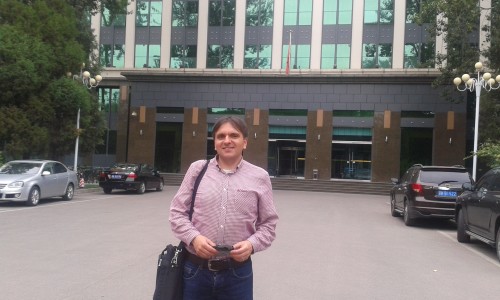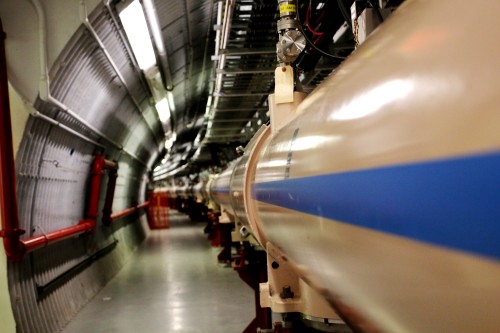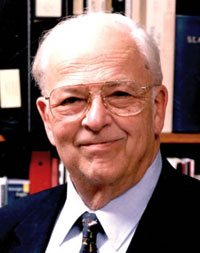Tag archives: collider
China eyes new high-energy collider

Matin Durrani outside the Institute of High Energy Physics in Beijing before interviewing Xinchou Lou.
By Matin Durrani in Beijing, China
I had just landed in Beijing this morning when I saw an e-mail from my colleague Mingfang Lu waiting for me on my phone. Mingfang, who’s editor-in-chief at the Beijing office of the Institute of Physics, which publishes Physics World, has been helping me to organize my itinerary for the next week as I gather material for our upcoming special report on physics in China. You may remember we published a Physics World special report on China in 2011 but so much has happened since then that we felt it’s easily time for another.
Mingfang’s e-mail was to say we would be off at 2.30 p.m. to interview Xinchou Lou, a particle physicist at the Institute of High Energy Physics, about the country’s ambitious plans for a “Higgs factory”. If built, this 240 GeV Circular Electron–Positron Collider (CEPC) would be a huge facility (50 km or possibly even 100 km in circumference) that will let physicists study the properties of the Higgs boson in detail. I say “if”, but knowing China’s frenetic progress in physics, it will almost certainly be a case of “when”.
View all posts by this author | View this author's profile
The unexpected benefit of a malfunctioning magnet at RHIC

Beam me down: in the RHIC tunnel. (Courtesy: Tushna Commissariat)
By Tushna Commissariat in New York City, US
I’m not one to rejoice in someone else’s misfortune, but I must admit that I couldn’t help but be a bit pleased when I heard that the Relativistic Heavy Ion Collider (RHIC) at the Brookhaven National Laboratory (BNL) had a malfunction last Friday. You see, I happened to be visiting the collider and its detectors yesterday, and if a malfunctioning superconducting magnet had not shorted a diode last Friday, I would not have had the chance to go down into the collider tunnel, which was a great experience.
RHIC – which, along with the Large Hadron Collider at CERN, is the only other detector capable of colliding heavy ions and is, in fact, the only spin-polarized collider in the world – has been running since the year 2000, and accelerator director Wolfram Fischer tells me that I am rather “lucky” as “failed magnets are very rare”. Indeed, he said that after initial teething problems when RHIC was switched on, this was the first such magnet failure that has occurred in the past 15 years. But fear not, the RHIC maintenance crew is already hard at work – the diode will soon be replaced and the collider should be up and running again in the next few days.
Build your own LEGO particle collider
By Michael Banks
You may remember last year when particle physicist Sascha Mehlhase of the Niels Bohr Institute in Copenhagen unveiled a 560-piece LEGO model of CERN’s ATLAS detector at the Large Hadron Collider.
Well, not to be outdone, LEGO fan Jason Allemann has now created a LEGO-inspired particle accelerator. Dubbed the LEGO Brick Collider (LBC), the design has been submitted to LEGO’s CUUSOO site, which lets fans share blueprints of their own models.
View all posts by this author | View this author's profile
Is desperation for new physics clouding our vision for new colliders?
By Hamish Johnston
This month marks the 60th anniversary of CERN and to kick-off our coverage here at physicsworld.com, I’m highlighting an essay on the future of collider physics that has just been written by Nobel laureate Burton Richter called “High energy colliding beams; what is their future?“.

Burton Richter warns against desperation. (Courtesy: Stanford University)
Richter shared his 1976 Nobel prize with Samuel Ting for their independent discoveries of the J/ψ meson. He knows his particle colliders, having helped to design and build the world’s first collider in the late 1950s at Stanford University and later directing the Stanford Linear Accelerator Center for 15 years.
Richter believes that the international community is not facing up to tough decisions that must be made about what to do when the Large Hadron Collider (LHC) is retired sometime in the early 2030s. He thinks that “the perspective of one of the old guys might be useful”.
Planning the next huge collider involves the co-operation of three main groups of physicists: those who design and build the accelerators; those who design and build the experiments; and the theoretical physicists who work out what the experiments are looking for. Richter thinks that this is not going well at the moment.
View all posts by this author | View this author's profile
Four quarks for Muster Mark?

Family of four? (Courtesy: Shutterstock/paul_june)
By Tushna Commissariat
In June we reported that physicists working on the BESIII experiment in Beijing and the Belle experiment in Tsukuba, Japan found evidence for a new “charged charmonium” called Zc(3900). A “charged charmonium” is a particle that is made of four quarks – something that had never been seen before. Since that discovery, the BESIII collaboration says it has made “a rapid string of related discoveries” of four-quark particles. “While quarks have long been known to bind together in groups of twos or threes, these new results seem to be quickly opening the door to a previously elusive type of four-quark matter,” says Frederick Harris, spokesman for the BESIII experiment. “The unique data sample collected by the BESIII collaboration has continued to yield a stream of clues about the nature of multi-quark objects.”
Much ado about the LHC

Rolf-Dieter Heuer talking to journalists at the Royal Society, London.
(Courtesy: Tushna Commissariat)
By Tushna Commissariat
The Large Hadron Collider (LHC) at CERN has had its share of good and bad press over the past few years. Controversy and rumours abounded when the machine was switched on in September 2008. The mood then turned quickly to disappointment when its magnets failed and finally to euphoria when the first beams collided at 7 TeV in March 2010.
This week, a meeting to discuss the LHC and all things related was held at the Royal Society in London. The “Physics at the High Energy Frontier – the Large Hadron Collider Project” meeting took place on 16–17 May and saw leading lights of the project come together to discuss the collider and its future.
I was at the meeting for the second day, when a press briefing was held where CERN director Rolf-Dieter Heuer, plus Fabiola Gianotti and Guido Tonelli of the ATLAS and CMS experiments respectively, answered all of the questions that the Higgs-hungry reporters could throw at them!
The three speakers described how the collider has “surpassed all expectations” – experimental and computational. Talking about how the LHC is the very essence of global co-operation, Tonelli stressed that “no country could have done it as a stand-alone”. Heuer boasted that every year about 1000 students get their PhDs thanks to the LHC, while just the ATLAS experiment involves about 3000 researchers.
Explaining how things work at the LHC, Tonelli said, “We [experimental scientists] try to test the theory without prejudice. We ask our friends the theorists to come up with something that we can observe.” The collider has already produced the top quark in Europe for the first time and now it is poised to begin a regime of “new physics”, to look for supersymmetry (SUSY), multiple dimensions, matter–antimatter disparity and, of course, the Higgs boson.
The Higgs…or something else?
“We will have an answer to the Shakespeare question for the Higgs – ‘To be or not to be’ – by the end of 2012” declared a confident Heuer. While he did show a great deal of enthusiasm about discovering the Higgs, Heuer was also keen to point out that not finding the particle would be a great result in itself. “Not finding [the Higgs] when it does not exist is a success,” he exclaimed. “If it does not exist, we need to find something else that takes up the job of the Higgs and gives mass to elementary particles,” he added.
The LHC will run until the end of 2012 without any major breaks and Heuer is confident that it will decide the fate of the Higgs by the end of this run. “Physics will not be the same after 2012.” declared Tonelli. “It will change the view of the world.”
Not amused
One of the first questions, asked by BBC reporter Pallab Ghosh, was about the recent ”leak” of an unconfirmed sighting of the Higgs by ATLAS. A sighting that was later denied by a paper released by the ATLAS team and in interviews with physicists on various media channels.
“Unfortunately we live in a world of WikiLeaks, so it leaked!” said a grinning Gianotti. On a more serious note, she explained that such leaked results have not undergone the scientific scrutiny that is necessary, and hence are almost always insubstantial.
“The CERN management was not amused by the leak” said Heuer. He went on to ask journalists not to believe leaked results in the future. “Don’t trust it on first sight” he said. Although Heuer’s displeasure was clear, the leak did put the LHC back in the public eye after a few quiet months. Also, the media interest did provide the public with a rare insight into the vetting process that all scientific discoveries undergo. So perhaps the CERN management should lighten up and enjoy the renewed interest in the LHC!

Rolf-Dieter Heuer giving a talk about the future of the LHC at the Royal Society, London. (Courtesy: Tushna Commissariat)
Bumps and jumps
When asked about the Higgs-like ‘bumps’ seen at other experiments like the Tevatron and CERN’s Large Electron Positron Collider (LEP) the panel had mixed replies. The Tevatron bump was dismissed by Gianotti and Tonelli, as they both explained that it was too small, statistically speaking, and was only seen by one of the Tevatron’s two detectors. Would the LHC have a look for the Tevatron signal? “No”, was their reply.
However, “interesting events” seen at 115 GeV by the LEP just before its closure in 2000 are of interest to them. While Heuer did say that it is very difficult to determine if it was anything more than a “hint”, the LHC will be looking for the Higgs at that energy soon.

Colliding linearly
The International Liner Collider – a possible successor to the LHC – is another project that Heuer is excited about. He feels that CERN, with the LEP and now the LHC under its belt, would be the perfect host for the collider. “I think CERN has huge potential, not only on the human side, but on its experience side. We have all the instruments. So I see CERN in a very good position.” he said.
But what about the money? “If you have an excellent science case, you will get the money. Don’t ask for the money until you have the science figured out.” he said. He pointed out that, compared to the US, in Europe the politics of funding are more stable and for that reason CERN would be a better host.
Right: prototype microwave cavity for the ILC, illuminated for a “Science Night” in Hamburg. (Courtesy: DESY)
View all posts by this author | View this author's profile